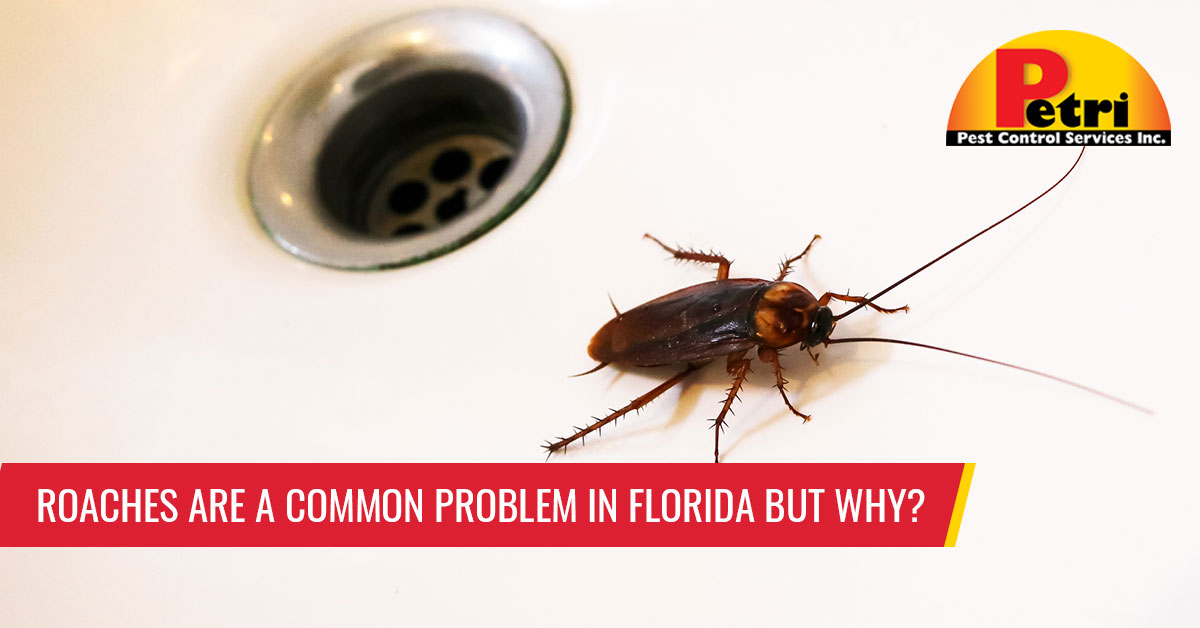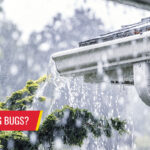
Roaches are a common problem in Florida but why are they so prevalent here versus other areas of the US? There are a lot of roaches in Florida so we’ll explore why our weather and living conditions make the environment conducive for them, and review the threat posed by roaches and what you can do to keep your home and family safe from them.
Florida’s warm and humid climate attracts many visitors and unfortunately, roaches. In fact, according to the United States Department of Housing and Urban Development (HUD), South and Southwestern Florida have some of the densest roach populations in the entire country. The study found that 30.4% of Florida homeowners report at least one infestation per year. Shockingly, 37.6% of Tampa Bay and St. Petersburg homeowners reported at least one roach infestation per year. In 2019, Miami was ranked third in the cities with the most roaches in the US, meaning that one in three homeowners in the Greater Miami area will likely be dealing with some roach situation every year. Can you relate?
The Problem with Roaches
Roaches are not only ugly and stinky, but they also pose some health threats to people and pets, in addition to causing property damage. The real problems with roaches are:
- Roaches are vectors for many human pathogens
Living in their own excrement, roaches are capable of transmitting many infectious diseases such as Cholera, Diarrhea, Dysentery, Leprosy, Bubonic Plague, Typhoid Fever, Salmonella, viral diseases, and other food-borne illnesses, according to the World Health Organization (WHO). - Roaches cause allergic reactions
Symptoms of roach-related allergies include sneezing, coughing, sinus infections, ear infections, nasal congestion, and wheezing that can’t be attributed to seasonal allergic reactions. According to The National Pest Management Association, 63% of homes in the US contain cockroach allergens and in urban areas, between 78% and 98% of homes showed proof of roach allergens. - Roaches physically damage your property
Roaches will damage the interior of your home, especially paper or wood in homes. Roaches are attracted to starch and will eat book bindings, cardboard, ceiling boards, paper, and even wallpaper if left unchecked. - Roaches make your home smell bad
Tracking their feces throughout your home, roaches leave an offensive odor in their wake. Additionally, roaches emit a pheromone, oleic acid, known as the “death stench” when they expire that can attract more roaches. - Roaches can rapidly prove impossible to control
Roach sightings can easily turn into full-blown infestations in a matter of weeks. Female German roaches can produce more than 300,000 offspring in one year with baby roaches reaching maturity in 36 days.
What are the Most Common Roaches in South Florida?
- American Cockroaches – Known as Palmetto bugs, these 2- to 3-inch dark brown to black roaches can be alarming as these giant cockroaches also fly. Not only do these pests fly but they’ve been known to fly directly at humans, mistaking them for trees. The good news is that these roaches only live inside to get out of the rain and when it’s convenient for them to do so, they enter homes through appliances, such as dishwashers with plenty of food available and water nearby.
- German Cockroaches – Easily the most destructive roach in South Florida, at about ½ inch long, German cockroaches appear light brown or tan with semi-transparent wings and two dark vertical stripes behind their heads. An indoor roach, German roaches have adapted well to living near humans, making their homes in dark, damp, warm spaces, such as under refrigerators, in crevices in drawers, under countertops, and in bathrooms. Although they’re most active at night, German roaches can be seen in the daytime if you have an infestation in your home. German cockroaches eat their own fecal matter and leave dark spots that can be seen in places where roaches spend most of their time. Not only is this dangerous to humans, but this unending cycle of roach excrement also attracts more roaches.
- Brown-Banded Cockroaches – Often confused with German cockroaches because of their size and color, brown-banded cockroaches can be distinguished from German cockroaches by a light brown circle on the top of their heads and the absence of two dark pronotal stripes. Similar to German cockroaches, brown-banded roaches also spend their entire life indoors. Unlike German cockroaches, brown-banded cockroaches, also known by some as “furniture roaches” prefer warm, dry habitats such as living rooms and bedrooms.
Other Roaches Common to South Florida include:
- Florida Woods Roaches – Smaller than American cockroaches, at about 1½ inches, and wingless, when one startles you in your bathroom at 3 a.m., it’s just passing through and not taking up residence in your home.
- Australian Cockroaches – Often mistaken for American cockroaches, yellow accents grace the Australian cockroach’s wings and they’re considered outdoor cockroaches.
- Smokybrown Cockroaches – Smaller than American cockroaches, smokybrown cockroaches are the most prevalent flying cockroaches in South Florida. Fortunately, these roaches prefer the outdoors and are attracted to lights, such as porch lights.
Roaches are Resilient
Roaches can thrive indoors and outdoors in climates with temperate weather conditions. South Florida presents the best of both worlds for roaches. Originating more than 280 million years ago in the Carboniferous era, roaches are highly adaptable to many environments.
- Roaches can survive underwater for about 40 minutes and can live without heads for a week. The ability to survive underwater for 40 minutes goes along with their ability to live without their heads for a week! With an open circulatory system and because they breathe through little holes in their body segments, roaches do not depend on a mouth or head to breathe. Roaches can only survive without their heads for a week because they need water to survive.
- Roaches are seriously fast, clocked at about 3 miles per hour. That doesn’t sound that fast but if you’re less than an inch long, running 3 miles per hour is quite impressive. That’s also why roaches are so hard to kill, because they can run so fast, avoiding capture by humans.
How Do You Control Roaches in Your Home?
The best way to control roaches in your home is to prevent roaches from entering your home.
- Seal all cracks, crevices, and entryways where roaches can enter your home, around your foundation, windows, and doorways.
- Trim tree branches away from your home.
- Keep grass cut short.
- Correct or repair water issues.
- Make sure downspouts are draining properly.
- Eliminate piles of debris from your property.
- Eliminate areas of dense vegetation.
- Stack firewood away from your home.
- Keep the interior of your home clean. This means wiping down all dining and food prep areas with a disinfectant and sweeping or vacuuming floors in dining and food prep areas after each snack or meal.
- Cleaning dishes immediately after snacks and meals is important. Don’t let dirty plates sit in the sink.
- Store food in air-tight containers or the fridge.
- Discard food scraps in tight-fitting receptacles.
- Sanitize outdoor trash receptacles and the area around your receptacles.
- Declutter your home, garage, patio, etc., and discard cardboard boxes. Plastic bins with tight-fitting lids are less inviting for roaches.
Should you discover that you have a roach issue, some home remedies might keep roaches at bay, such as commercial baits and rubbing a cucumber on surfaces, as some people believe that roaches are repelled by the scent of cucumbers. However, the most efficient and effective way to eliminate roaches is to contact a professional pest control company for cockroach removal services, such as Petri Pest Control Services. Professional pest control technicians are trained to use powerful baits and other materials in cockroach services that aren’t available over the counter.
Got a roach problem? Save yourself time and money by contacting Petri Pest Control Services for a free pest inspection of your Broward or Palm Beach County home.
Roaches Are A Common Problem In Florida But Why in Pompano Beach?
Pest Control in Pompano Beach and Boynton Beach


